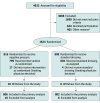Effect of Prophylactic Negative Pressure Wound Therapy vs Standard Wound Dressing on Surgical-Site Infection in Obese Women After Cesarean Delivery: A Randomized Clinical Trial
- PMID: 32960242
- PMCID: PMC7509615
- DOI: 10.1001/jama.2020.13361
Effect of Prophylactic Negative Pressure Wound Therapy vs Standard Wound Dressing on Surgical-Site Infection in Obese Women After Cesarean Delivery: A Randomized Clinical Trial
Abstract
Importance: Obesity increases the risk of both cesarean delivery and surgical-site infection. Despite widespread use, it is unclear whether prophylactic negative pressure wound therapy reduces surgical-site infection after cesarean delivery in obese women.
Objective: To evaluate whether prophylactic negative pressure wound therapy, initiated immediately after cesarean delivery, lowers the risk of surgical-site infections compared with standard wound dressing in obese women.
Design, setting, and participants: Multicenter randomized trial conducted from February 8, 2017, through November 13, 2019, at 4 academic and 2 community hospitals across the United States. Obese women undergoing planned or unplanned cesarean delivery were eligible. The study was terminated after 1624 of 2850 participants were recruited when a planned interim analysis showed increased adverse events in the negative pressure group and futility for the primary outcome. Final follow-up was December 18, 2019.
Interventions: Participants were randomly assigned to either undergo prophylactic negative pressure wound therapy, with application of the negative pressure device immediately after repair of the surgical incision (n = 816), or receive standard wound dressing (n = 808).
Main outcomes and measures: The primary outcome was superficial or deep surgical-site infection according to the Centers for Disease Control and Prevention definitions. Secondary outcomes included other wound complications, composite of surgical-site infections and other wound complications, and adverse skin reactions.
Results: Of the 1624 women randomized (mean age, 30.4 years, mean body mass index, 39.5), 1608 (99%) completed the study: 806 in the negative pressure group (median duration of negative pressure, 4 days) and 802 in the standard dressing group. Superficial or deep surgical-site infection was diagnosed in 29 participants (3.6%) in the negative pressure group and 27 (3.4%) in the standard dressing group (difference, 0.36%; 95% CI, -1.46% to 2.19%, P = .70). Of 30 prespecified secondary end points, 25 showed no significant differences, including other wound complications (2.6% vs 3.1%; difference, -0.53%; 95% CI, -1.93% to 0.88%; P = .46) and composite of surgical-site infections and other wound complications (6.5% vs 6.7%; difference, -0.27%; 95% CI, -2.71% to 2.25%; P = .83). Adverse skin reactions were significantly more frequent in the negative pressure group (7.0% vs 0.6%; difference, 6.95%; 95% CI, 1.86% to 12.03%; P < .001).
Conclusions and relevance: Among obese women undergoing cesarean delivery, prophylactic negative pressure wound therapy, compared with standard wound dressing, did not significantly reduce the risk of surgical-site infection. These findings do not support routine use of prophylactic negative pressure wound therapy in obese women after cesarean delivery.
Trial registration: ClinicalTrials.gov Identifier: NCT03009110.
Conflict of interest statement
Figures


Comment in
-
Wound Dressings for Obese Women After Cesarean Delivery.JAMA. 2021 Feb 16;325(7):693. doi: 10.1001/jama.2020.24195. JAMA. 2021. PMID: 33591338 No abstract available.
-
Proof of ineffective and unnecessary prophylactic negative-pressure wound dressing (NPWD) after caesarean: extended debate to include surgical considerations.BJOG. 2022 Feb;129(3):509-510. doi: 10.1111/1471-0528.16911. Epub 2021 Oct 6. BJOG. 2022. PMID: 34612576 No abstract available.
References
-
- Hall MJ, DeFrances CJ, Williams SN, Golosinskiy A, Schwartzman A. National hospital discharge survey: 2007 summary. Natl Health Stat Report. 2010;(29)1-20, 4. - PubMed
-
- Hamilton BE, Martin JA, Ventura SJ, Osterman MJK, Curtin SC, Rossen LM Births: provisional data for 2018. Vital Statistics Rapid Release. Report No. 007. Published May 2019. Accessed March 20, 2020. https://www.cdc.gov/nchs/data/vsrr/vsrr-007-508.pdf?utm_source=morning_brew

